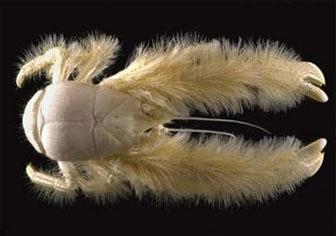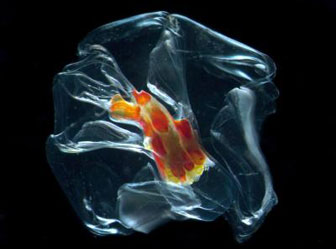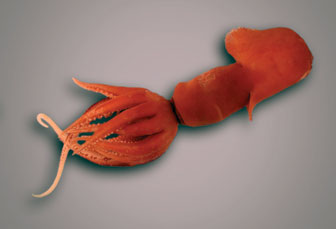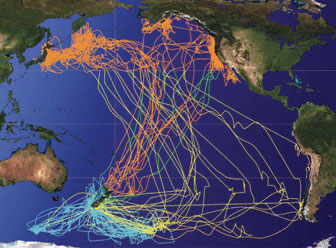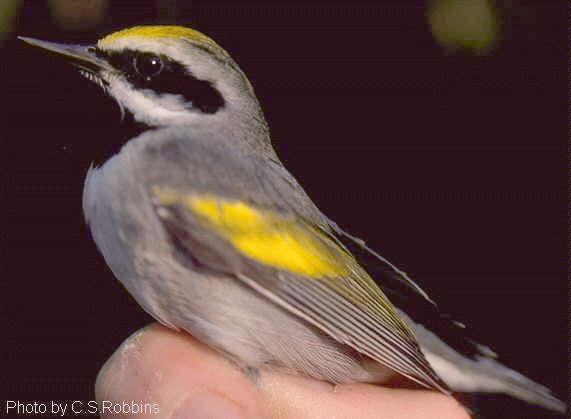Some 500 previously unknown species of marine life were discovered during the latest Census of Marine Life (CoML), a research effort involving some 2000 researchers from 80 countries. The discoveries, made during 19 ocean expeditions in 2006, included a gigantic 1-centimeter in diameter single-celled organism in the Nazare Canyon off Portugal, a "blonde-haired" lobster near Easter Island, a "chewing" squid, and a four-pound (1.8 kg) lobster off Madagascar.
"
Each Census expedition reveals new marvels of the ocean – and with the return of each vessel it is increasingly clear that many more discoveries await marine explorers for years to come," said Fred Grassle, Chair of the Census Scientific Steering Committee. Now in its sixth year, the Census is working to record the diversity, distribution, and abundance of global marine life. Among its many findings in 2006:
Species discovery
| Kiwa hirsuta, the Yeti crab, a new species found
near Easter Island. Credit: Ifremer/A. Fifis ©2006.
A colonial siphonophore: several swimming
bells surround red and yellow feeding
tenticles. Grows to 1.5 cm. From the
Danish Galathea 3 expedition off Broome
in Northwestern Australia, November 2006.
Photo Credit, Russ Hopcroft,
University of Alaska Fairbanks ©2006
A new species of squid, Promachoteuthis sloani,
found along the Mid-Atlantic Ridge.
Credit: MAR-ECO/R. Young ©2006.
Tracks of tagged sooty shearwaters as they made
their way back and forth across the Pacific Ocean.
Credit: TOPP ©2006
|
Macro microbe. The protozoan that Census explorers of the continental margins discovered in the Nazare Canyon off Portugal differs from the usual protozoans seen swimming in a drop of water under a microscope. The single cell of this fragile new species of Xenophyophore, found at 4,300 m depth, is enclosed within a plate-like shell, 1 cm in diameter, composed of mineral grains.
Furry crab. Near Easter Island, Census researchers discovered a crab so unusual it warranted a whole new family designation, Kiwaidae. Beyond adding a new family to the wealth of known biodiversity, its discovery added a new genus, Kiwa, named for the mythological Polynesian goddess of shellfish. Its furry or hairy appearance justified its species name, hirsuta.
A squid that chews. Among the 80,000 organisms – encompassing 354 families, genera and species – that Census deep-sea investigators collected from the Mid-Atlantic Ridge was the reference specimen or holotype for a new species of squid: Promachoteuthis sloani. Although collection easily damages the soft cephalopods, the hard beaks are unique to each species, including that of the new squid, which looks quite capable of chewing its food.
Komoki in Antarctic waters. Komokiaceae or "komoki" dominate deep-sea foraminifera, protozaons with false feet used for locomotion and food collection. In the Weddell Sea, where ice crushed the ship of Antarctic explorer Shackleton in 1915, Census polar researchers found 59 komoki and komoki-like species, at least 42 unknown to science.
Doubling Zooplankton. Census zooplankton researchers discovered 3 new genera and 31 new species of copepods and mysids, small crustaceans, in Southeast Asian, Australian, and New Zealand waters. Analysis of collections from biodiversity hotspots, the deep sea, and other unexplored regions is on track to double the number of known zooplankton species
Extremes of Science
Hottest. At a thermal vent 3 km below the surface in the equatorial Atlantic, Census researchers found shrimp and other life forms on the periphery of fluids billowing from Earth’s core at an unprecedented marine recording of 407ºC, a temperature that would melt lead easily. Although the species resemble those around other vents, scientists want to study how, surrounded by near-freezing 2ºC water, their chemistry allows them to withstand heat pulses that approach the boiling point – up to 80ºC. Shrimp were seen on the walls of the vent chimney. Others in the habitat include mussels and clams. All somehow tolerate an environment of extreme temperature changes within a few centimeters and high concentrations of heavy metals from the vent fluids.
Darkest. Southern Ocean census takers revealed an astonishing community of marine life shrouded beneath 700 meters of ice – 200 km from open water. Equally remarkable, sampling of this most remote ocean’s depths during three lengthy cruises yielded more new than familiar species.
Most. Census fish counters' observation off the New Jersey coast of 20 million fish swarmed in a school the size of Manhattan Island qualifies as most new abundance found. Sound emitted by a new ship-based technology illuminates life in an oceanic area tens of thousands times larger than previously possible. It updates instantaneously and continuously, revealing the extension and shrinking, fragmentation and merging of the island-sized swarms as a person might watch schools of minnows swimming in a brook beneath a bridge.
Deepest. Sampling 5 km below the surface in the Sargasso Sea, deploying a unique trawl configuration that filtered large volumes of water for rare-but-diverse zooplankton living in the ocean’s deepest depths, Census experts from 14 nations caught these drifting, often soft and elusive animals in a sophisticated net, the MOCNESS. They collected more than 500 species, including 12 likely new species, eating each other at the great depths or living on organic matter falling like snow from above. (CMarZ photo of menacing-looking, animals such as this amphipod, a small prawn-like crustacean, the supposed inspiration for the movie Alien.
Oldest. Census seamount researchers found a shrimp, believed extinguished 50 million years ago, alive and well on an underwater peak in the Coral Sea. Neoglyphea neocaledonica was nicknamed "Jurassic shrimp" by its discoverers, who say it rivals the find in South Africa and Indonesia of the coelacanth, a prehistoric fish previously known only through fossils.
Richest. In the sense that biodiversity is richness, Census microbe hunters found 20,000 kinds floating in a single liter of sea water. Samples were taken from the Atlantic and Pacific, including from an eruptive fissure 1,500 meters deep on a seamount in the Pacific a few hundred kilometers west of Oregon, USA. Revealed by DNA studies, most of the different kinds of bacteria were unknown and likely rare globally. The richness of the diversity invites speculation about what rare species contribute to their biosphere and an estimate that the kinds of bacteria in the oceans exceed five to 10 million. The researchers also began assembling the best-ever video of protists (mostly microscopic organisms that are neither animals, plants, or fungi) and to pioneer optical and genetic techniques to extend the limits of knowledge. (The video is available for media at the embargoed media materials URL. Credit: Jeremy Pickett-Heaps)
Farthest. Tracking tagged sooty shearwaters by satellite, Census researchers mapped the small bird’s 70,000 km search for food in a giant figure eight over the Pacific Ocean, from New Zealand via Polynesia to foraging grounds in Japan, Alaska and California and then back. Making the longest-ever electronically-recorded migration in only 200 days, the bird averaged a surprising 350 km daily. In some cases, a breeding pair made the entire journey together.
Largest. Among the many new species discovered by Census participants during 2006, a 1.8 kg (4 lb) rock lobster that Census explorers found off Madagascar may be the largest. Named Palinurus barbarae, the main body spans half a meter.
While the census found hundreds of previously unknown species -- including 150 species of fish -- the researchers behind the project also found evidence that marine biodiversity is in decline due to human influences. "The historical studies of the CoML agree with recent studies showing steep declines of most wild populations of marine animals that people eat," says Grassle.
According to a CoML news release, researchers "reconstructed the changing abundance of marine life in 12 estuaries and coastal seas around the world. In archives from Roman times in the Adriatic Sea, the medieval era in Northern Europe, to Colonial times in North America and Australia, they confirmed the fears that exploitation and habitat destruction depleted 90 percent of important species. They also confirmed elimination of 65 percent of seagrass and wetland habitat, a 10 to 1,000-fold degradation of water quality, and accelerated species invasions."
"The past richness of the oceans in many near shore regions is hard for people today to believe," added Grassle. Despite the declines, the census says that the research will help humans better utilize marine resources going forward. "The dream of abundant and sustainable stocks of commercial fish is now one step closer, thanks to this Census of Marine Life program. The new data reveal for the first time those zones of the ocean where we have the highest leverage for conservation and thus smarter fishing," said D. James Baker, President of the Academy of Natural Sciences of Philadelphia.
CoML found that marine preservation efforts are working in some areas, with "signs of transitions from degradation to recovery where conservation was implemented during the 20th century." Looking towards 2010, CoML seeks to have completed an initial census describing what lived, now lives, and will live in the oceans. "The vast expanse of the oceans, the rarity of some animals, their movements, and fluctuations challenge Census researchers. Happily, the astonishing progress of the past six years shows the community will create the first-ever Census of Marine Life in 2010," said Jesse Ausubel, a program manager for the Sloan Foundation, a Census sponsor.
"Together, we can see the wonders of the ocean and excite the world to preserve and increase them," added Ron O’Dor, CoML Senior Scientist.
 It is well known that animals use song as a way of attracting mates, but researchers have found that gibbons have developed an unusual way of scaring off predators -- by singing to them.
It is well known that animals use song as a way of attracting mates, but researchers have found that gibbons have developed an unusual way of scaring off predators -- by singing to them.





